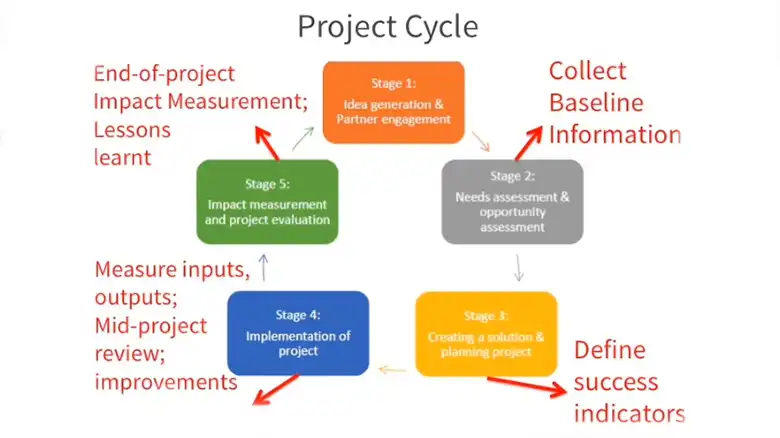How to Measure Impact of a Project
In the dynamic landscape of project management, understanding and quantifying the impact of a project is paramount. It goes beyond the surface-level success metrics and delves into the intricacies that define a project’s true value.
This article will guide you through the essential steps of measuring project impact, providing a comprehensive roadmap for effective evaluation.

Significance of Measurement
In the realm of project management, understanding the significance of measuring impact is akin to having a compass in uncharted territory. It is the beacon that guides project managers toward success and illuminates the true value a project brings to the table.
Why Measure Impact
Measuring impact is not a mere formality; it is the linchpin that holds together the entire project management structure.
It unravels the layers of a project, exposing both its tangible and intangible contributions. This process is crucial in aligning project efforts with the overarching goals of the organization.
Connecting the Dots
Every project, no matter its size, is a puzzle piece contributing to the larger organizational picture. By measuring impact, we establish a clear connection between the individual projects and the grand objectives of the organization.
It ensures that every project serves a purpose beyond its immediate scope, contributing meaningfully to the organizational narrative.
Driving Success Beyond Surface Metrics
While success metrics might paint a rosy picture on the surface, impact measurement delves deeper. It reveals the intricacies and nuances of a project’s influence, giving stakeholders a comprehensive understanding of its true value.
In essence, measuring impact is not just about checking boxes; it’s about steering projects toward meaningful success.
Establishing Clear Objectives
In the realm of project impact measurement, the foundation for success lies in the establishment of clear objectives. This crucial step is akin to charting a course on a map before embarking on a journey—it provides direction, purpose, and a measurable framework for assessing the project’s influence.
Defining SMART Objectives
Clear objectives should be SMART: Specific, Measurable, Achievable, Relevant, and Time-Bound. This ensures that the goals set are precise, quantifiable, attainable, aligned with the project’s mission, and bound by a timeframe for evaluation.
Specific objectives bring focus, eliminating ambiguity. Rather than a vague goal like “improve customer satisfaction,” a specific objective would be “increase customer satisfaction ratings by 15%.”
Measurable criteria enable tangible assessment. Numbers and metrics turn abstract goals into quantifiable targets, allowing for a comprehensive evaluation of the project’s impact.
Achievable objectives ensure that the goals set are realistic within the given constraints—be it resources, time, or scope. Unrealistic objectives can hinder progress and demotivate teams.
Relevant objectives tie directly to the project’s overarching mission and goals. They contribute meaningfully to the project’s success and align with the organization’s broader objectives.
Time-Bound objectives establish a timeframe for achievement, providing a sense of urgency and a clear timeline for impact assessment. This temporal dimension adds structure to the project’s trajectory.
Aligning Objectives with Project Goals
Clear objectives should seamlessly align with the broader goals of the project. They act as guiding stars, directing efforts toward outcomes that genuinely matter and contribute significantly to the project’s overall success.
Aligning objectives with project goals ensures a cohesive strategy. For instance, if the project’s goal is to enhance customer experience, the objectives might include improving response times, reducing query resolution times, or implementing customer feedback mechanisms.
This alignment fosters synergy, ensuring that every task and milestone contributes meaningfully to the project’s overarching mission. It’s not just about completing tasks; it’s about achieving milestones that collectively drive the project forward.
Communicating Objectives Effectively
Clear communication is paramount in the establishment of objectives. It’s not merely about jotting down goals but ensuring that every team member understands them. Effective communication fosters a shared vision, aligning the entire team towards common objectives.
Regular meetings, concise documentation, and visual aids can aid in communicating objectives. A well-defined roadmap that outlines the path from current status to the achievement of objectives helps everyone comprehend their role in the grand scheme.
Stakeholder Involvement
Stakeholders are the heartbeat of any project, and involving them in the impact measurement process is crucial for a comprehensive evaluation. Their perspectives, insights, and expectations shape the narrative of how a project’s influence is perceived within and beyond the organization.
Understanding Stakeholder Involvement
Engaging stakeholders in the impact measurement journey is akin to opening a dialogue. It’s not just about presenting findings; it’s about including them in defining what success looks like. This involvement ensures that the assessment captures the diverse facets of the project’s impact.
The Role of Stakeholders
Stakeholders aren’t passive observers; they are active contributors to the project’s success story. By involving them in impact measurement, you tap into a wealth of experiences, expectations, and concerns that might otherwise be overlooked.
This collaborative approach enhances the accuracy and relevance of the impact assessment.
Gathering Diverse Perspectives
Stakeholders represent a spectrum of interests – from internal teams to external partners and clients. Involving this diverse group ensures that impact criteria consider the varied expectations each stakeholder holds.
It’s about creating a well-rounded picture that reflects the multifaceted nature of a project’s influence.
Practical Steps for Stakeholder Involvement
Early Engagement: Involve stakeholders from the project’s inception, ensuring alignment between their expectations and project goals.
Transparent Communication: Maintain open and transparent communication channels to keep stakeholders informed about the impact measurement process.
Collecting Feedback: Actively seek feedback on the defined impact criteria, incorporating stakeholders’ perspectives into the assessment framework.
Regular Updates: Provide regular updates on the progress of impact measurement, keeping stakeholders engaged and informed throughout the project lifecycle.
Workshops and Meetings: Conduct workshops or meetings to discuss impact findings, encouraging stakeholders to share their insights and interpretations.
Benefits of Stakeholder Involvement
Enhanced Accuracy: Stakeholder involvement brings nuance to the impact assessment, ensuring that it accurately reflects the project’s real-world influence.
Improved Buy-In: When stakeholders are part of the process, they are more likely to buy into the results, fostering a sense of ownership and commitment.
Holistic Understanding: By including diverse perspectives, the impact measurement becomes a holistic representation of how the project affects various aspects of the organization.
Identification of Blind Spots: Stakeholders can uncover blind spots that might be missed when assessing impact solely from a project management perspective.
Baseline Data Collection
In the realm of measuring project impact, baseline data collection stands as the crucial foundation upon which a comprehensive evaluation is built. It is the starting point, the snapshot of conditions and variables before a project takes its course.
Understanding the Essence
Baseline data collection involves gathering essential information about the current state of affairs within the project’s scope.
This initial data is like a reference point against which future progress and changes can be compared. It’s akin to marking the water level before a tide—a benchmark for measuring the impact’s rise or fall.
Why is it Important
Before embarking on any project, understanding the existing conditions is imperative. Baseline data helps identify the status quo, offering insights into the challenges and opportunities that lie ahead. It’s the groundwork for setting realistic goals and measuring the tangible impact of the project over time.
Building a Historical Context
Think of baseline data as the backstory of your project. It provides a historical context, allowing project managers and stakeholders to trace the journey from inception to the current point.
By understanding where you started, you gain a clearer perspective on the path ahead and the impact your project can potentially achieve.
Ensuring Accurate Measurement
Accurate measurement requires a reference point. Baseline data acts as a stable platform, ensuring that the impact is not measured in isolation. Changes and developments can be accurately gauged against the initial conditions, offering a more nuanced and accurate assessment of the project’s influence.
Implementation in Real-world Scenarios
Consider a community development project aiming to reduce unemployment. The baseline data would include the current unemployment rate, key demographics, and other relevant economic factors.
As the project progresses, changes in employment figures can be measured against this baseline, providing a tangible measure of impact.
Steps in Baseline Data Collection
Identify Key Parameters: Determine the essential factors that directly relate to the project’s goals. For instance, if the project aims to improve educational outcomes, key parameters might include current literacy rates, school attendance, and access to educational resources.
Utilize Existing Data: Before starting from scratch, explore existing data sources. Government reports, surveys, and other relevant studies can provide a foundational understanding of the current situation, saving both time and resources.
Customize for Specifics: Tailor your data collection to the specific needs of your project. This might involve conducting surveys, interviews, or utilizing technology for more intricate data points.
Document Methodology: Transparency is key. Clearly document how the baseline data is collected—what methods are used, who is involved, and any potential limitations. This documentation ensures the reliability and replicability of your findings.
Cost-Benefit Analysis
In the realm of project management, a critical facet of measuring impact lies in the thorough examination of costs and benefits. A cost-benefit analysis is akin to the financial heartbeat of a project, revealing the economic implications of its endeavors.
Understanding the financial dynamics of a project is crucial for informed decision-making. A cost-benefit analysis delves into the monetary investments made and the returns generated, providing a clear picture of the project’s economic viability.
Why Does Cost-Benefit Analysis Matter
Cost-benefit analysis serves as the compass for project managers navigating the complex terrain of resource allocation. It is not just about dollars and cents; it’s about ensuring that every penny invested yields a commensurate value in return.
Weighing the Costs
The analysis begins by meticulously identifying and quantifying all the costs associated with the project. This includes direct expenses such as equipment, labor, and materials, as well as indirect costs like administrative overhead.
In simple terms, think of it as taking a detailed inventory of everything you spend money on to make the project a reality. No cost is too small to escape scrutiny.
Quantifying Tangible and Intangible Benefits
Once the costs are laid bare, the focus shifts to the benefits. Benefits, in the context of a project, extend beyond mere financial gains. They encompass both tangible outcomes, such as increased revenue, and intangible gains, like enhanced brand reputation.
Quantifying these benefits involves assigning a value to each, often a task that demands a careful balance between objective measurement and subjective evaluation.
Striking a Balance
The essence of a successful cost-benefit analysis lies in achieving equilibrium. It’s about ensuring that the benefits derived from the project not only outweigh the costs but do so in a manner that aligns with the goals and objectives of the undertaking.
In simpler terms, it’s akin to a financial seesaw – the benefits must tip the scales in your favor.
Decision-Making Power
Armed with the insights garnered from a robust cost-benefit analysis, project managers are empowered to make well-informed decisions. Should the project proceed, undergo modification, or be reconsidered altogether? These decisions hinge on the financial wisdom distilled from the analysis.
Real-Time Monitoring
Real-time monitoring is the dynamic compass guiding project managers through the currents of change.
In the realm of project impact measurement, this practice stands as a vigilant sentinel, ensuring that assessments are not confined to historical data but remain adaptable and responsive to the unfolding project narrative.
The Essence of Real-Time Monitoring
Real-time monitoring is not merely an auxiliary aspect of impact measurement; it’s the pulse that keeps a project alive and thriving.
Unlike retrospective evaluations, this approach provides an immediate, continuous assessment of a project’s health, allowing for agile decision-making and timely course corrections.
Ensuring Immediate Response
In the fast-paced world of project management, delays can be costly. Real-time monitoring empowers project managers with the ability to respond immediately to emerging trends, challenges, or opportunities.
It transforms impact assessment from a periodic event into an ongoing dialogue with the project’s unfolding reality.
Proactive Decision-Making
Waiting for quarterly or annual reports to gauge impact is akin to steering a ship blindfolded. Real-time monitoring acts as the captain’s eyes, offering a proactive view of the project’s trajectory. Project managers can make informed decisions in the moment, steering the project toward success.
Agile Adaptation to Change
Projects are dynamic entities, susceptible to unforeseen shifts. Real-time monitoring allows for agile adaptation, ensuring that the project aligns with its objectives even in the face of unexpected challenges. It’s the compass that recalibrates, maintaining the project’s course in changing waters.
Swift Identification of Deviations
In the intricate dance of project execution, deviations are inevitable. Real-time monitoring acts as a vigilant choreographer, swiftly identifying any missteps or variations from the intended impact.
This immediacy allows for prompt corrective actions, preventing minor deviations from escalating into major setbacks.
Tools and Technologies for Real-Time Monitoring
To implement effective real-time monitoring, project managers leverage a variety of tools and technologies.
These can include project management software, data analytics platforms, and communication tools that facilitate seamless information flow, ensuring that no crucial detail goes unnoticed.
Integrating Real-Time Monitoring into Project Culture
Embracing real-time monitoring isn’t just about adopting tools; it’s a cultural shift within the project team. Encouraging a mindset of constant awareness and responsiveness ensures that real-time monitoring becomes ingrained in the project’s DNA, influencing decision-making at every level.
Challenges and Considerations
While the benefits of real-time monitoring are evident, challenges may arise. These could include data accuracy concerns, integration issues with existing systems, or resistance to change within the project team.
Identifying and addressing these challenges is crucial for the successful implementation of real-time monitoring practices.
Usual Questions
Q1: Why is measuring the impact of a project important?
A1: Measuring impact is crucial for several reasons. It provides insights into a project’s success, helps in understanding its contributions to organizational goals, and guides decision-making for future endeavors.
Essentially, it’s the compass that ensures projects are not just completed but contribute meaningfully to overall success.
Q2: What are the key components of impact measurement?
A2: Impact measurement involves various components, including setting clear objectives, engaging stakeholders, collecting baseline data, conducting cost-benefit analysis, and employing real-time monitoring.
Each component plays a vital role in comprehensively assessing a project’s impact from different perspectives.
Q3: How do stakeholders contribute to impact measurement?
A3: Stakeholders actively contribute by defining impact criteria. Their involvement ensures a well-rounded understanding of the project’s influence, incorporating diverse perspectives and expectations.
Engaging stakeholders from the outset enhances the accuracy and relevance of impact measurement.
Q4: What is the significance of real-time monitoring in project impact measurement?
A4: Real-time monitoring is the practice of continuously assessing a project’s progress and impact as it unfolds.
It enables immediate response to emerging trends, facilitates proactive decision-making, and ensures agile adaptation to change. It’s the dynamic compass that keeps a project on course in a rapidly evolving environment.
Q5: How does real-time monitoring differ from traditional assessment methods?
A5: Unlike traditional methods that rely on periodic assessments, real-time monitoring provides an ongoing, immediate evaluation of a project’s health.
It allows project managers to identify and address issues promptly, steering the project toward success in the present moment rather than waiting for retrospective analysis.
Q6: What tools and technologies are used for real-time monitoring?
A6: Real-time monitoring leverages various tools and technologies, including project management software, data analytics platforms, and communication tools. These tools facilitate seamless information flow, enabling project managers to stay informed and make timely decisions based on current data.
Q7: How can organizations integrate real-time monitoring into their project culture?
A7: Integrating real-time monitoring is not just about adopting tools; it’s a cultural shift. Organizations can foster a culture of constant awareness and responsiveness by promoting training, encouraging open communication, and showcasing the benefits of real-time monitoring through successful implementation in projects.
Q8: What challenges might arise in implementing real-time monitoring?
A8: Challenges in implementing real-time monitoring can include concerns about data accuracy, integration issues with existing systems, and resistance to change within the project team.
Identifying and addressing these challenges proactively is essential for the successful adoption of real-time monitoring practices.
Q9: Can real-time monitoring be applied to all types of projects?
A9: Yes, real-time monitoring can be adapted to various project types. While the specific tools and methodologies might vary, the principles of continuous assessment and immediate response can be applied across diverse projects, enhancing their overall effectiveness.
Q10: How does real-time monitoring contribute to long-term project sustainability?
A10: Real-time monitoring contributes to long-term sustainability by allowing project managers to identify and address issues promptly. This proactive approach ensures that the project remains on a sustainable course, adapting to changes and preventing issues from escalating into long-term setbacks.
End Note
In the complex tapestry of project management, measuring impact is the golden thread that weaves success. From setting clear objectives to engaging stakeholders and employing real-time monitoring, each step is a brushstroke contributing to the masterpiece of project impact.
Embrace these strategies, and watch as your projects not only succeed but leave a lasting imprint on the organizational canvas.





